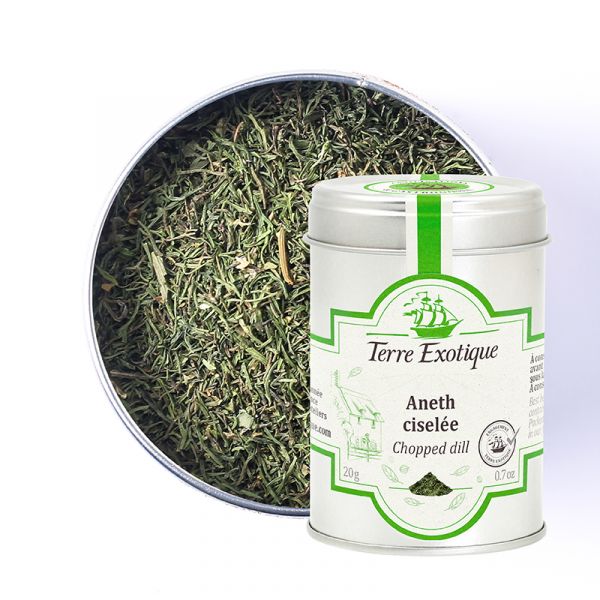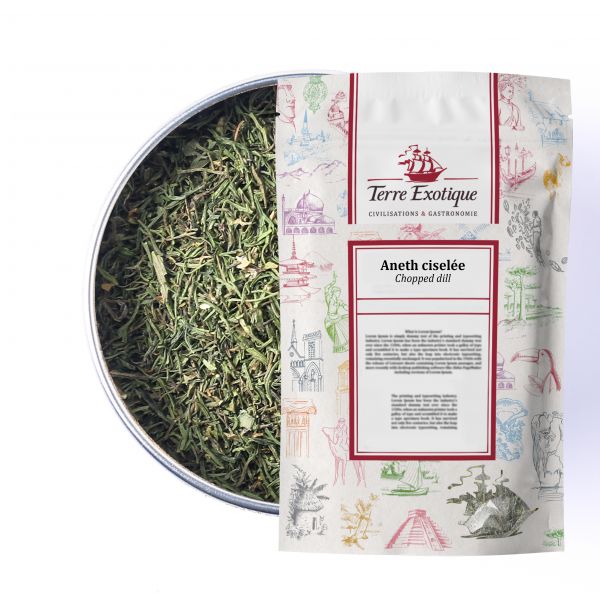



How to Use Chopped Dill in Your Kitchen?
Use it as a condiment in your cream sauces, vinaigrettes, or marinades. Its subtle fragrance pairs exceptionally well with fish and seafood, whether sprinkled on fillets before cooking or incorporated into accompanying sauces. Try it in dairy-based dishes such as fresh cheeses, yogurts, and yogurt sauces.
Some Recipe Ideas Using Chopped Dill:
- - Dill Salmon: bake or pan-sear salmon fillets, then generously top them with freshly chopped dill. Serve with a lemony cream sauce for a perfect flavor combination;
- - Roasted Potatoes with Dill: cut potatoes into wedges, season with olive oil, salt, pepper, and dill, then roast in the oven until golden and crispy;
- - Dill Tzatziki: prepare a tzatziki sauce by mixing Greek yogurt, grated cucumber, minced garlic, and dill. Serve with raw vegetables or as a side for grilled meats;
- - Grilled Dill Chicken: season chicken breasts with salt, pepper, and dill, then grill them. Serve with a lemony dill sauce;
- - Dill Risotto: add finely chopped dill to a creamy risotto for a fresh and herby flavor;
- - Steamed Vegetables with Dill: steam vegetables like carrots, zucchini, or green beans, then season with melted butter, salt, and dill.
Aromas of Chopped Dill
The delicate and finely chopped leaves of dill release a refreshing freshness, perfectly balanced with sweet and aromatic undertones. Its light and pleasant taste make it an ideal accompaniment for fish and seafood, but its versatility extends to a variety of other dishes, from salads to sauces.
About the Botany of Dill
Dill (Anethum graveolens) belongs to the Apiaceae family, which also includes parsley, fennel, and carrots. This annual herbaceous plant is characterized by its hollow and delicate stems, reaching up to one meter in height, and its finely divided leaves, resembling a feathery appearance. The small yellow flowers grouped in umbels add a touch of elegance to the plant. Dill thrives in temperate and sunny climates, developing its best aroma before flowering. Its seeds, also used in cooking, are flat, oval, and emit a slightly aniseed fragrance.
Dill and Its Unusual Use
The name "dill" comes from the Latin "anethum," which means "strong-smelling." In the Middle Ages, some people wore bags filled with dill on their chests to ward off witches and the evil eye. Germans also created a tradition around dill, which involves placing the plant in the shoes of newlyweds to ensure the longevity of their marriage.
| Allergen | Absence |
|---|---|
| Native country | UE / NON UE |
| Genus and botanical species | Anethum graveolens |
| Ingredients | dill leaf |
| Nutritional Info | VN Energie pour 100 g (energy for 100g) : 1059 kJ / 253 kcal VN Matière grasse (fat) : 4.4 g Dont acide gras saturés (of which saturated fat) : 0.2 g VN Glucides (carbohydrate) : 55.8 g Dont sucres (of which sugars) : 0 g VN Protéines (protein) : 20 g Vn Sel (salt) : 0.2 g |
| TRACES EVENTUELLES D'ALLERGÈNES | céleri, sésame, moutarde, fruits à coques. |
 Français
Français 